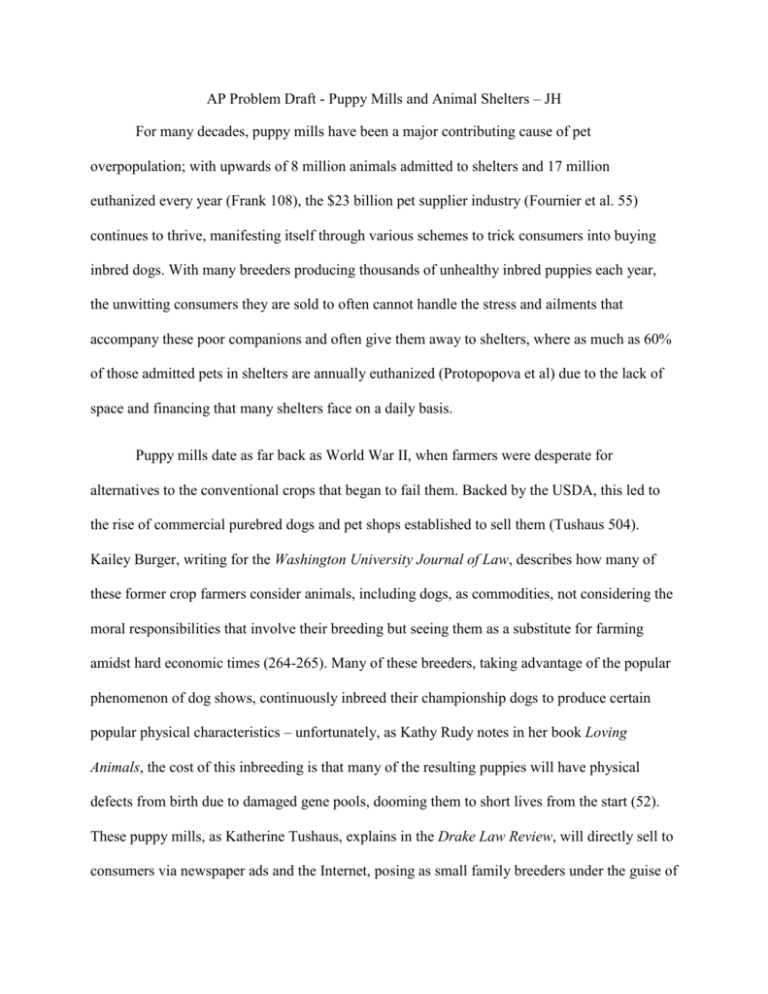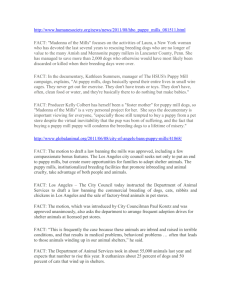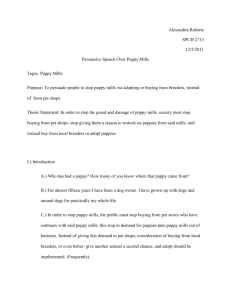File
advertisement

AP Problem Draft - Puppy Mills and Animal Shelters – JH For many decades, puppy mills have been a major contributing cause of pet overpopulation; with upwards of 8 million animals admitted to shelters and 17 million euthanized every year (Frank 108), the $23 billion pet supplier industry (Fournier et al. 55) continues to thrive, manifesting itself through various schemes to trick consumers into buying inbred dogs. With many breeders producing thousands of unhealthy inbred puppies each year, the unwitting consumers they are sold to often cannot handle the stress and ailments that accompany these poor companions and often give them away to shelters, where as much as 60% of those admitted pets in shelters are annually euthanized (Protopopova et al) due to the lack of space and financing that many shelters face on a daily basis. Puppy mills date as far back as World War II, when farmers were desperate for alternatives to the conventional crops that began to fail them. Backed by the USDA, this led to the rise of commercial purebred dogs and pet shops established to sell them (Tushaus 504). Kailey Burger, writing for the Washington University Journal of Law, describes how many of these former crop farmers consider animals, including dogs, as commodities, not considering the moral responsibilities that involve their breeding but seeing them as a substitute for farming amidst hard economic times (264-265). Many of these breeders, taking advantage of the popular phenomenon of dog shows, continuously inbreed their championship dogs to produce certain popular physical characteristics – unfortunately, as Kathy Rudy notes in her book Loving Animals, the cost of this inbreeding is that many of the resulting puppies will have physical defects from birth due to damaged gene pools, dooming them to short lives from the start (52). These puppy mills, as Katherine Tushaus, explains in the Drake Law Review, will directly sell to consumers via newspaper ads and the Internet, posing as small family breeders under the guise of innocent names like “Tanni’s Precious Paws” and “Rainbow Ranch” (The Humane Society of the United States) with the incentive of free shipping across the nation; they are often nonchalant with their standards for who to sell to, and do not provide any form of identity to avoid further contact with their buyers after the purchase is done. Many retailers source their pets from these rural commercial breeders; common pet shops buy from these retailers, often without knowing where the animals truly came from (Tushaus 504). The dogs are then sold, to everyday shop visitors who rely on the shops’ credibility in their purchases. Many of these inbred puppies are inevitably be sent to shelters, considering the intense behavior training and expensive vet bills that are required to normalize these puppies back into society. As one study by veterinarian Franklin D. McMillan et al., found, dogs from puppy mills not only had more health problems but exhibited distinct levels of fear and nervousness, with compulsive behaviors, sensitivity to touch, and less aggression and excitability. Once sent to the shelters, they live in spatial restriction with extreme temperatures and limited human interaction, inciting more reclusiveness and timidity (McMillan et al). Unfortunately, this change of behavior for the worse only keeps them in the shelter longer; as one study by Alexandra Protopopova, applied animal behavior professor at the University of Florida, et al. found, certain behaviors related to seclusion like facing away from or leaning against the walls of the enclosure, correlated to longer lengths of stay for the dogs at the shelter they sampled from. Thus, an ongoing cycle of already damaged mill dogs are sent into animal shelters, where their behavioral and mental conditions worsen and their hopes of being adopted lessen until the shelters finally decide to euthanize them because they believe “they are forced to kill the unadoptable dogs almost immediately, saving space for the adoptable ones, which they will hold as long as they can” (Rudy 62); these animals live an almost perpetual cycle entrenched in miserable conditions for much of their pre-determined short lives. Although laws exist that attempt to regulate these problematic puppy mills as shown in Figure 1, they are hardly enforced due to lackadaisical organization and implementation allowed by state and federal law. As Burger notes, some states do have “lemon laws” in place which are designed to protect the consumer by requiring contracts signed by the breeders guaranteeing the health of Fig 1. A graphic of states with puppy mill laws and the extent they are defined to. Those states in purple are the most stringent in their definitions with required licensing and inspection, those in blue only require licensing and limits without inspections, while those in gray have no laws that specifically address puppy mills. (HSUS) their puppies or replacements otherwise. Unfortunately, many other puppy mill laws aren’t as easy to support or enforce. For example, when it comes to federal laws like the Animal Welfare Act signed in 1966 designated to inspect breeders and oversee interstate transactions, they are defined loosely with minimal standards (“structural sound facilities with water twice a day”), but are strict in that some laws might only apply to animal dealers, leaving breeders free of conviction. Even given these rudimentary definitions, there isn’t enough funding for the program that oversees puppy mills, and accordingly there aren’t enough inspectors to adequately enforce the laws that might be pushed by advocacy organizations, with only 96 USDA inspectors expected to oversee the thousands of puppy mills nationwide (as well as zoos, circuses, and laboratories) (HSUS) – of those that exist, it is still difficult to inspect puppy mills given their largely rural locations where farms once were. With many deficiencies on the federal level, states are often left on their own to implement their own laws to oversee the potential hundreds of puppy mills that hide within. Given that many of these breeders are former farmers, the enormous agriculture industry often pushes for laxer inspection policies and regulations in each state – breeders can then move to those states with more relaxed laws to avoid any persecution whatsoever; this is perhaps best exemplified with Missouri being known as the “Puppy Mill Capital” of the US, with 33 to 40 percent of the country’s mill-bred dogs originating from that state (Burger 265). Overall, despite the various laws that might be set into place federally or by state, many are haphazardly defined and cannot properly be enforced given the lack of resources of those in charge, leaving many breeders to continue business without much opposition. Puppy mills as a whole have been a thriving industry for many decades, making business via the Internet but primarily through pet stores, and selling upwards of 500,000 puppies every year (HSUS). Unabated by the state and federal laws set to restrict them, they seek to maximize their annual profits (with one investigated breeder earning $290,000 one year) by forcing their females to reproduce as much as possible in slave-like conditions, yielding puppies that are doomed to shorter lifespans and multiple health problems before they even begin their lives. Under continued exposure to the cramped, stressful environments of these puppy farms, they develop behavioral problems that can cause their new owners stress, which leads to their disownment into shelters. Many then live the rest of their lives at these shelters, their overall conditions worsening the longer they stay, meaning lesser chances of being adopted into nice homes again – they stay there in captivity with many others of their kind, until their eventual euthanizing by the shelter workers. Many hundreds of thousands of puppies are born each year suffering these same, similar fates, as a result of the unrelenting breeders that continue to go unopposed. Works Cited Burger, Kailey A. "Solving the Problem of Puppy Mills: Why the Animal Welfare Movement's Bark is Stronger than its Bite." Wash. UJL & Pol'y 43 (2013): 259. Fournier, Angela K., and E. Scott Geller. "Behavior analysis of companion-animal overpopulation: A conceptualization of the problem and suggestions for intervention." Behavior and Social Issues 13.1 (2005): 51-68. Frank, Joshua. "An interactive model of human and companion animal dynamics: the ecology and economics of dog overpopulation and the human costs of addressing the problem." Human Ecology 32.1 (2004): 107-130. McMillan, Franklin D., Deborah L. Duffy, and James A. Serpell. "Mental health of dogs formerly used as ‘breeding stock’ in commercial breeding establishments." Applied Animal Behaviour Science 135.1 (2011): 86-94. Protopopova, Alexandra, et al. "In-Kennel Behavior Predicts Length of Stay in Shelter Dogs." PloS one 9.12 (2014): e114319. Rudy, Kathy. Loving Animals: Toward a New Animal Advocacy. Minneapolis: U of Minnesota, 2011. 42-66. Print. Shaw, Anthony E. "Prisoners of Profit (Puppy Mills)." Petfinder Prisoners of Profit Puppy Mills Comments. Petfinder, n.d. Web. 09 May 2015. <https://www.petfinder.com/helpingpets/puppy-mills/prisoners-profit-puppy-mills/>. The Humane Society of the United States. State Puppy Mill Laws. Digital image. The Humane Society of the United States. N.p., n.d. Web. 19 May 2015. <http://www.humanesociety.org/assets/pdfs/pets/puppy_mills/state_map_puppy_mill_la ws.JPG?credit=web_id359552774>. The Humane Society of the United States. "A Horrible Hundred Selected Puppy Mills in the United States." (2013): n. pag. May 2013. Web. 19 May 2015. <http://www.humanesociety.org/assets/pdfs/pets/puppy_mills/100-puppy-mills-list.pdf>. The Humane Society of the United States. "Get the Facts on Puppy Mills." (n.d.): n. pag. Web. 19 Mar. 2015. <http://animalrightscoalition.com/doc/puppy_mills_factsheet.pdf>. Tushaus, Katherine C. "Don't Buy the Doggy in the Window: Ending the Cycle That Perpetuates Commercial Breeding With Regulation of the Retail Pet Industry." Drake J. Agric. L. 14 (2009): 501.






